Sewage plant to alter Armory
From his spot behind the counter at Nancy’s Coffee Cafe in Armory Square, Paul Hacker watched as handfuls of people passed through the park in front of his shop.
On one warm spring day, the park welcomed a steady stream of people stopping to enjoy a brief rest in the fresh air away from their offices.
‘People like to go get their lunch, grab a cup of coffee and sit out there in the park when it’s nice,’ he said. ‘I like this little area down here.’
Like the rest of Armory, it provides visitors with a quaint haven inside of its hectic downtown surroundings, and an escape for Syracuse University students looking to get off the Hill. But some businessmen like Hacker fear that a sewage treatment facility slated for the area will detract people from the neighborhood, along with their business.
‘People come down here to relax,’ he said. ‘That’s going to have a serious effect on the ambiance. Who’s going to want to come and sit in a restaurant next to a sewage plant?’
The proposal for the plant is part of the $380 million county plan to clean up Onondaga Lake. The plan, which came as a consent judgment following a 1988 lawsuit filed by Atlantic States Legal Foundation, also includes a facility on Midland Avenue and at Harbor Brook. New York State and the state Department of Environmental Conservation both supported the suit and approved the final plan.
Opposition from neighbors in the Midland area and the City of Syracuse has slowed the county’s construction of the three facilities.
Like the contested plant on Midland Avenue, the proposed plant near Armory would operate during times of heavy rainfall, separating wastes and sending solids to the city’s main treatment facility on Hiawatha Boulevard for decontamination. The byproducts will be deposited into Onondaga Creek.
Critics of the Midland project, who have gained the support of several SU student groups, argue that an above-ground sewage plant will hurt property values and attach a stigma to the neighborhoods housing the plants. They advocate the construction of an underground storage facility, which would hold waste underground until it is transported to the main facility for treatment.
The county contends that it selected the sites for the plants based on the location of combined sewer overflows. Also, spatial and financial restrictions make underground storage an unrealistic solution.
Amidst this heated debate over the Midland project, the Armory proposal has managed to stay out of the spotlight, so much so that some speak of the plan in an indirect way.
‘Some of the Armory owners have been lulled into a sense that this is never going to happen,’ said Peter Thompson, who works with Atlantic States Legal Foundation. ‘People in the community have written it off because it just goes on and on.’
While some Armory businesses were willing to discuss the issue, David Church, president of the Armory Square Business Association, said the group is waiting to hear more about the plan before making any comments about the project.
Though the Armory facility’s construction may seem unlikely to some, the county has every intention of completing the plan, said Mike Cunningham, manager of the lake cleanup project. The county expects some protest from the Armory community, Cunningham added.
But while opposition may be the same within both communities, Armory businessmen may have more power to influence the county than south side residents, said Arthur Paris, a sociology professor at SU.
‘You see this time and again,’ he said of the Midland situation. ‘You have a population that is impoverished, that lacks professional workers and is black. Without other mechanisms to represent their interests, they’re going to get screwed.’
Yet the county insists it will use the same model for each project to ensure fairness among the effected communities. County representatives continue to emphasize this in meetings with its Midland opposition, and say they must negotiate with the other communities in mind.
Regardless of the outcome, both neighborhoods share similar fears for what the plant may bring, including decreased property values and a negative stigma.
While the county refutes concerns that the plant will smell and make noise, Tom Ranger, an employee at Pastabilities, said he frequently hears people complain about the stench around the main treatment plant near the Carousel Center. Such an odor could have a serious effect on businesses that thrive on outdoor activity, like some of the restaurants in Armory.
‘People are always outside down here,’ he said. ‘The smell would drive people away.’
Aside from these post-construction concerns, Hacker said, he sees the actual building of the facility to be a greater problem. Congested and closed streets will surely drive away business, he said.
Despite these apprehensions, Steve Karon, director of the Museum of Science and Technology, said he sees the facility as a chance to educate the public.
‘Because of its proximity to the MOST, it makes sense to use it as an opportunity to explain some of the science behind it,’ Karon said.
And while Karon agreed the project may bring some disruption, he sees it as inevitable.
‘It’s a necessary thing,’ he said. ‘The goal is to clean up the lake. In order to do this, we need the plant. No matter whether people like it or not, it has to go there.’
Published on April 28, 2003 at 12:00 pm




